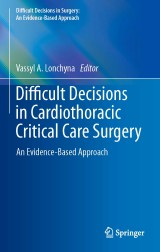Details

Difficult Decisions in Cardiothoracic Critical Care Surgery
An Evidence-Based ApproachDifficult Decisions in Surgery: An Evidence-Based Approach
|
171,19 € |
|
| Verlag: | Springer |
| Format: | |
| Veröffentl.: | 13.02.2019 |
| ISBN/EAN: | 9783030041465 |
| Sprache: | englisch |
Dieses eBook enthält ein Wasserzeichen.
Beschreibungen
<p>Critical care medicine is responsible for many of the most important advances in outcomes after cardiothoracic surgery in the past two decades. The expertise developed in this subspecialty accounts for the resiliency that characterizes gold standard results evident in institutions recognized for excellence. This volume is intended to share ideas and algorithms that will improve outcomes in cardiothoracic critical care units. </p> <p>This book is part of the <i>Difficult Decisions in Surgery</i> series that covers surgical specialties. The volumes are multi-authored, containing brief chapters, each of which are devoted to one or two specific questions or decisions within that specialty that are difficult or controversial. The volumes are intended as a current and timely reference source for practicing surgeons, surgeons in training, and educators that describe the recommended ideal approach, rather than customary care, in selected clinical situations. </p>
1. Introduction.- 2. Evaluating evidence.- 3. Quality and Value in the Cardiothoracic ICU.- 4. Fungal Infection in the ICU.- 5. Palliative Care in the ICU.- 6. Ethics: When to turn off the VAD.- 7. Care in the ICU.- 8. Defibrillation/pacing first for witnessed cardiac arrest in postop cardiac surgery.- 9. Early Re-Sternotomy in post-op cardiac surgery patients who suffer cardiac arrest.- 10. Epinephrine and Vasopressin use following cardiac arrest in post-op cardiac surgery.- 11. Role of early sternotomy after cardiac arrest in minimally invasive surgery patients.- 12. Intravascular Devices in the ICU.- 13. Central Venous Oxygen Saturation vs. Mixed Venous Oxygen Saturation Monitoring in Patients After Cardiac Surgery.- 14. The utility of hemodynamic waveform analysis in the ICU.- 15. Pressors and Vasodilators in the CT ICU: Getting the mixture right.- 16. Pocket ECHO in the CT ICU: helpful or just another toy?.- 17. Prevention of postoperative atrial fibrillation.- 18. Does aggressivetreatment of postoperative atrial fibrillation improve outcomes?.- 19. Role of noninvasive ventilation in the CT ICU.- 20. Daily Awakening of Ventilated Patients and Extubation after Cardio-thoracic Surgery.- 21. ECMO for Salvage of Influenza Patients.- 22. When on ECMO: Awaken, Extubate and Mobilize.- 23. ECMO as bridge to lung transplantation.- 24. Right Ventricular Failure.- 25. My LVAD patient is fully anticoagulated and vomiting blood.- 26. LVAD patient with dark urine and elevated LDH: Diagnose and Treat Thrombosis.- 27. Misadventures with IABP: troubleshooting and interventions.- 28. Liver dysfunction in VAD patients.- 29. Percutaneous assist devices as salvage from cardiogenic shock.- 30. Vasoplegia In the postoperative period after Cardiac Transplantation.- 31. Severe Hypertension after Cardiac Transplantation.- 32. Post-Transplant Right Ventricular Failure.- 33. Lung Inifiltrate in post-op Lung Transplant Patient: Pneumonia, Rejection or Edema?.- 34. Handling Secretions after lung transplantation.- 35. Early Nutrition in Cardiothoracic patients in the ICU.- 36. Glycemic Control does matter in the Post cardiac surgery patient.- 37. Problems of the morbidly obese patient following cardiothoracic surgery.- 38. The Bleeding Post-op CT patient: coagulation tests vs. thromboelastography.- 39. Bleeding post cardiac surgery.- 40. If the platelets are low, is it HIT?.- 41. Newest Antithrombotic Agents: Uses, Abuses, Reversals for Surgical Procedures.- 42. Coagulopathy in the Heart Failure Patient.- 43. Should Blood Conservation Tactics in the Jehovah's Witness patient be applied universally?.- 44. Incidence and Causes AKI in the Cardiothoracic ICU.- 45. Role of Biomarkers in Predicting AKI in the CT ICU.- 46. Diuretic Use in the Postop CT patient: Does it Prevent or Improve AKI?.- 47. Cardiorenal Syndrome in Heart failure patients: ICU management.- 48. Access for RRT in CT patients with No Place for Access.- 49. Free Air in the Popstoperative CT patient: Observe or Operate?.- 50. Ischemic bowel in the post cardiothoracic patient.- 51. Ischemic Stroke in the CT patient: Thrombolytic or Stent?.- 52. Confusion in the ICU: management of anticoagulated VAD patient with MS changes.- 53. Cerebral edema in the CT ICU: to bolt or not to bolt?.- 54. Malperfusion After Aortic Dissection/Aneurysm Repair: when is intervention warranted?.- 55. Ischemic Leg Following IABP Insertion: Timing of Diagnosis and Treatment. <p></p>
Dr. Vassyl A. Lonchyna is a cardiothoracic surgeon and a surgical intensivist in Chicago, Illinois (USA), affiliated with The University of Chicago. He received his medical degree from Wayne State University School of Medicine, his surgical training at Duke University and Loyola University and his surgical critical care training at Stroger Hospital in Chicago. He has been in practice for more than 30 years. <br>
<p>Critical care medicine is responsible for many of the most important advances in outcomes after cardiothoracic surgery in the past two decades. The expertise developed in this subspecialty accounts for the resiliency that characterizes gold standard results evident in institutions recognized for excellence. This volume is intended to share ideas and algorithms that will improve outcomes in cardiothoracic critical care units. </p><p>This book is part of the <i>Difficult Decisions in Surgery</i> series that covers surgical specialties. The volumes are multi-authored, containing brief chapters, each of which are devoted to one or two specific questions or decisions within that specialty that are difficult or controversial. The volumes are intended as a current and timely reference source for practicing surgeons, surgeons in training, and educators that describe the recommended ideal approach, rather than customary care, in selected clinical situations.</p>
Covers all major topics in subject area Only book in the subject area to take follow an evidence-based approach Contains a global perspective within many international authors
<p>Covers all major topics in subject area </p><p>Only book in the subject area to take follow an evidence-based approach<br></p> <p>Contains a global perspective within many international authors </p>
Diese Produkte könnten Sie auch interessieren:

Razum prestupnika i logika prestupleniya. O psihiatrii, sudah i seriynyh ubiytsah

von: Shohom Das, Dmitry Chepusov

6,99 €

















